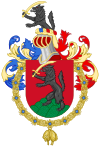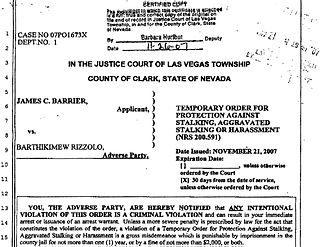Arms of the Presidents of the French Republic
| Arms or emblem | Name of president and blazon |
|---|---|
| Charles Louis-Napoleon Bonaparte, President of the French Republic from 1848 to 1852. Azure an Eagle displayed head to the sinister Or, holding in its talons a thunderbolt also Or. Crest: The Imperial Crown of France Or | |
  | Adolphe Thiers, President of the French Republic from 1871 to 1873.
No motto. As a Knight of the Spanish Order of the Golden Fleece he bore the crest: Three Ostrich feathers Azure, Or and Azure Torse: Or and Azure Mantling: Or lined Azure |
| Patrice de MacMahon, Duke of Magenta, President of the French Republic from 1873 to 1879. Ancestral arms: Argent, three Lions passant regardant in pale Gules Crest: an arm clutching a sword Mantling: Argent lined Gules Motto: Sic Nos Sic Sacra Tuemur (Latin for "Thus We Defend Our Sacred Rights") | |
 | Jules Grévy, President of the French Republic from 1879 to 1887. On appointment as a Knight of the Swedish Order of the Seraphim, he did not specify what arms he wanted for his stall plate. Therefore, his stall plate shows an unpainted shield. |
  | Marie François Sadi Carnot, President of the French Republic, 1887-1894. Ancestral arms: Azure, three Martlets, and in chief a Mullet, all Argent Supporters: Two lions Gules Motto: 'Honneur, Loyauté, Devoir' (French: 'Honour, Loyalty, Duty') |
  | Jean Casimir-Perier, President of the French Republic, 1894-1895. Ancestral arms: Azure, a Bend Or, in dexter chief a Lion's head erased Argent crowned Or As a Knight of the Spanish Order of Charles III, he used the crest: Four ostrich feathers Azure, Or, Argent and Azure Torse: Or, Argent and Azure Mantling: Or lined per pale Azure and Argent |
 | Félix Faure, President of the French Republic, 1895-1899. Azure, a Cipher composed of two letter Fs in saltire Or
Three ostrich feathers Azure, Or and Azure Torse: Or and Azure Mantling: Or lined Azure |
  | Émile Loubet, President of the French Republic from 1899 to 1906. Assumed on his induction into the Order of the Seraphim: Azure, a branch of Laurel surmounted by a Cipher composed of the letters E&L Or Motto: Virtute et labore (Latin: "virtue and work") As a Knight of the Spanish branch of the Order of the Golden Fleece; he used the crest: As a Knight of the Spanish Order of Charles III, he used the crest: Three ostrich feathers Azure, Or and Azure Torse: Or and Azure Mantling: Or lined Azure |
  | Armand Fallières, President of the French Republic from 1906 to 1913. Assumed on his induction into the Order of the Seraphim: Azure, a Cipher composed of the letters A&F Or Motto: l'homme ne vaut que par le bien qu'il fait (French: "we are judged by our deeds")[ citation needed ] As a Knight of the Spanish Order of Charles III, his arms were instead: Azure, a cypher consisting of the letters A and two Fs conjoined all Or and used the crest: Three ostrich feathers Or, Azure and Or. Torse: Or and Azure Mantling: Or lined Azure |
  | Raymond Poincaré, President of the French Republic from 1913 to 1920. Assumed on his induction into the Order of the Seraphim: Azure, a Cipher composed of the letters R&P Or As a Knight of the Spanish branch of the Order of the Golden Fleece; he used the crest: Three ostrich feathers Azure, Or and Azure Torse: Or and Azure Mantling: Or lined Azure |
| Paul Deschanel, President of the French Republic in 1920. Argent an oval Azure charged with a branch of olive and a branch of oak in Saltire charged with a fasces per pale and a ribbon with the motto LIBERTE EGALITE FRATERNITE all Or | |
| Alexandre Millerand, President of the French Republic from 1920 to 1924. Argent an oval Azure charged with a branch of olive and a branch of oak in Saltire charged with a fasces per pale and a ribbon with the motto LIBERTE EGALITE FRATERNITE all Or | |
 | Gaston Doumergue, President of the French Republic from 1924 to 1931. Azure, a Cipher composed of the letters G&D Or As a Knight of the Spanish Order Three ostrich feathers Or and Azure Torse: Or and Azure Mantling: Or lined Azure |
| Paul Doumer, President of the French Republic in 1931. Argent an oval Azure charged with a branch of olive and a branch of oak in Saltire charged with a fasces per pale and a ribbon with the motto LIBERTE EGALITE FRATERNITE all Or | |
| Albert Lebrun, President of the French Republic, 1931-1940. No arms known. | |
 | Vincent Auriol, President of the French Republic, 1947-1954. Azure, a branch of Olive and a branch of Oak in Saltire charged with a fasces per pale and a ribbon with the motto LIBERTE EGALITE FRATERNITE all Or
|
 | Rene Coty, President of the French Republic, 1954-1959. Azure, a branch of Olive and a branch of Oak in Saltire charged with a fasces per pale and a ribbon with the motto LIBERTE EGALITE FRATERNITE all Or as Knights of the Order of Christ:
|
  | Charles de Gaulle, President of the French Republic, 1959-1969. Ancestral arms: Tierced in fess Argent, Gules, and Azure, the Argent charged with three oak galls Gules slipped and leaved Vert, the Azure charged with three trefoils slipped Or. Assumed on him being admitted to the Order of the Seraphim on 8 May 1963: Per pale Azure and Gules, on a Pale Argent a Patriarchal Cross of the Second Motto: France Libre (French for Free France) |
| Georges Pompidou, President of the French Republic, 1969-1974. No arms known | |
   | Valéry Giscard d'Estaing, President of the French Republic, 1974-1981. Assumed on him being admitted to the Order of the Seraphim on 6 June 1980: Azure a Fasces Or bindings Argent between two Laurel sprigs disposed orleways of the second and bound together in base by a ribbon of the third. No motto.
Torse: Or, Argent and Azure Mantling: Or lined per pale Azure and Argent |
  | François Mitterrand, President of the French Republic from 1981 to 1995. May have been related to an armigerous family. Assumed on his being admitted to the Order of the Seraphim: Azure, a Tree eradicated Or No motto. As a Knight of the Spanish Order of Isabel the Catholic; he uses the crest: A tree Or Torse: Or and Azure Mantling: Or lined Azure |
 | Jacques Chirac, President of the French Republic, 1995-2007. Admitted to the Order of the Seraphim on 10 April 2000. His stallplate as a Knight of the Order of the Seraphim shows the emblem of the French Republic: Or, the letters R and F conjoined Or Supporter: A fasces Or -all surrounded by to the dexter, a sprig of laurel Or, and to the sinister, a sprig of oak Or, and the Collar of the Order of the Seraphim. No motto. |
  | Nicolas Sarkozy, President of the French Republic, 2007-2012. Ancestral arms: Gules, on a Mount Vert a Wolf rampant Proper, holding in its dexter paw a Sabre Or Crest: A Wolf rampant Proper, holding in its dexter paw a Sabre Or Torse: Or, Azure and Gules Mantling: to the dexter, Or lined Azure, and to the sinister, Or lined Gules. No motto. |
 | François Hollande, President of the French Republic, 2012–2017. His stallplate as a Knight of the Order of the Seraphim shows a similar representation to that of former President Chirac; with differences:
Supporter: A fasces Argent -all surrounded by to the dexter, a sprig of laurel Azure, and to the sinister, a sprig of oak Gules, and the Collar of the Order of the Seraphim. No motto. |
| Emmanuel Macron, President of the French Republic, 2017–present. No arms known. |





















